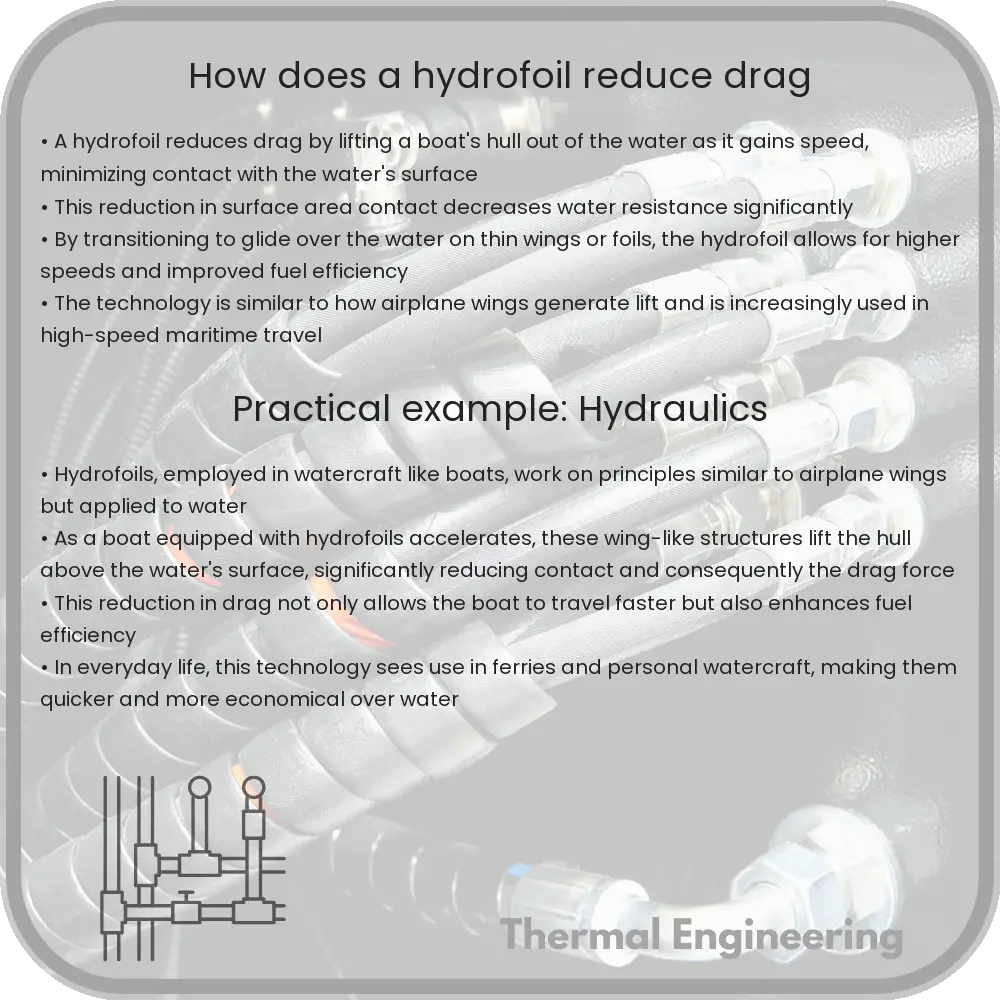Learn how hydrofoils enhance speed and efficiency in watercraft by lifting hulls above the surface to significantly reduce drag forces.

Understanding Hydrofoils: How They Reduce Drag
Hydrofoils are a type of engineering marvel that allow boats and other watercraft to achieve higher speeds and improved efficiency. They achieve this by lifting a vessel’s hull above the water’s surface, drastically reducing drag. In this article, we will explore what drag is, how hydrofoils are designed, and the physics behind how they reduce drag.
What is Drag?
Drag is a force that acts opposite to the direction of movement through a fluid, which in the case of watercraft, is water. This resistance is caused by friction and differences in pressure and generally, has two components: skin friction drag and form drag. Skin friction drag is due to the friction between the water and the surface of the vessel, whereas form drag is caused by the water’s resistance against the shape of the vessel.
Design and Functionality of Hydrofoil
A hydrofoil is essentially a wing that operates underwater. Much like an airplane wing, it has a special shape called an airfoil that alters the pressure distribution around it as it moves through water. When water passes over the hydrofoil, it generates lift perpendicular to the direction of flow, similar to how an airplane’s wings generate lift as they move through the air.
- Lift: This is generated due to differences in pressure on the top and bottom surfaces of the hydrofoil. The shape of the hydrofoil is such that it causes water flowing over the top surface to accelerate and decrease in pressure, according to Bernoulli’s Principle, which states that an increase in the speed of the fluid occurs simultaneously with a decrease in pressure.
- Thrust: Some advanced hydrofoil designs also generate thrust through propellers or jets that further enhance the speed of the vessel.
How Hydrofoils Reduce Drag
By lifting the hull of the watercraft above the surface of the water, hydrofoils significantly reduce both forms of drag:
- Reduction in Skin Friction Drag: When a vessel is supported by hydrofoils, a substantial portion of the hull is no longer in contact with the water. Since skin friction drag is a product of the contact area between the vessel’s hull and the water, minimizing this contact decreases the drag from skin friction.
- Reduction in Form Drag: With the hull above the water surface, the hydrodynamic shape of the hull contributes less to the overall form drag. The effective area subjected to form drag is notably reduced, as the smaller, streamlined hydrofoils navigate through the water instead of the entire hull.
In practical terms, this reduction in drag results in higher speeds and lower fuel consumption, making hydrofoil-equipped vessels more efficient than conventional ones. The effectiveness of hydrofoils is particularly evident in high-speed applications, such as ferries and racing boats, where efficiency and speed are critical.
Conclusion
Hydrofoils represent a significant advancement in naval engineering, allowing vessels to achieve higher speeds and increased operational efficiency by effectively reducing drag. Their design leverages fundamental principles of physics to lift a vessel above the water, minimizing resistance and maximizing performance. As technology advances, we can expect hydrofoils to become even more prevalent in various maritime applications.
Whether for commercial or recreational use, the principles behind hydrofoils demonstrate the fascinating ways that engineering and physics can combine to solve practical problems—such as reducing drag to improve the speed and efficiency of waterborne transport.